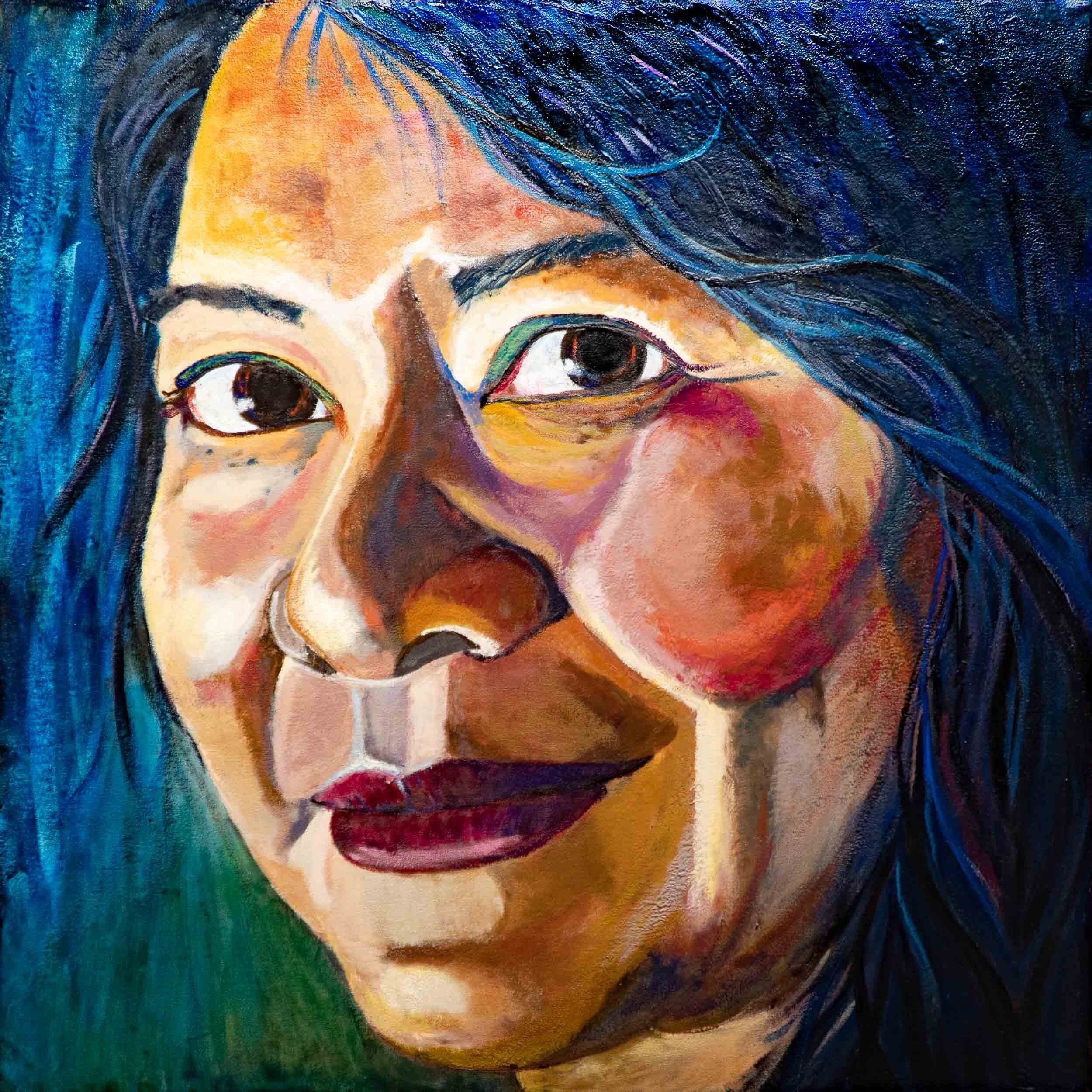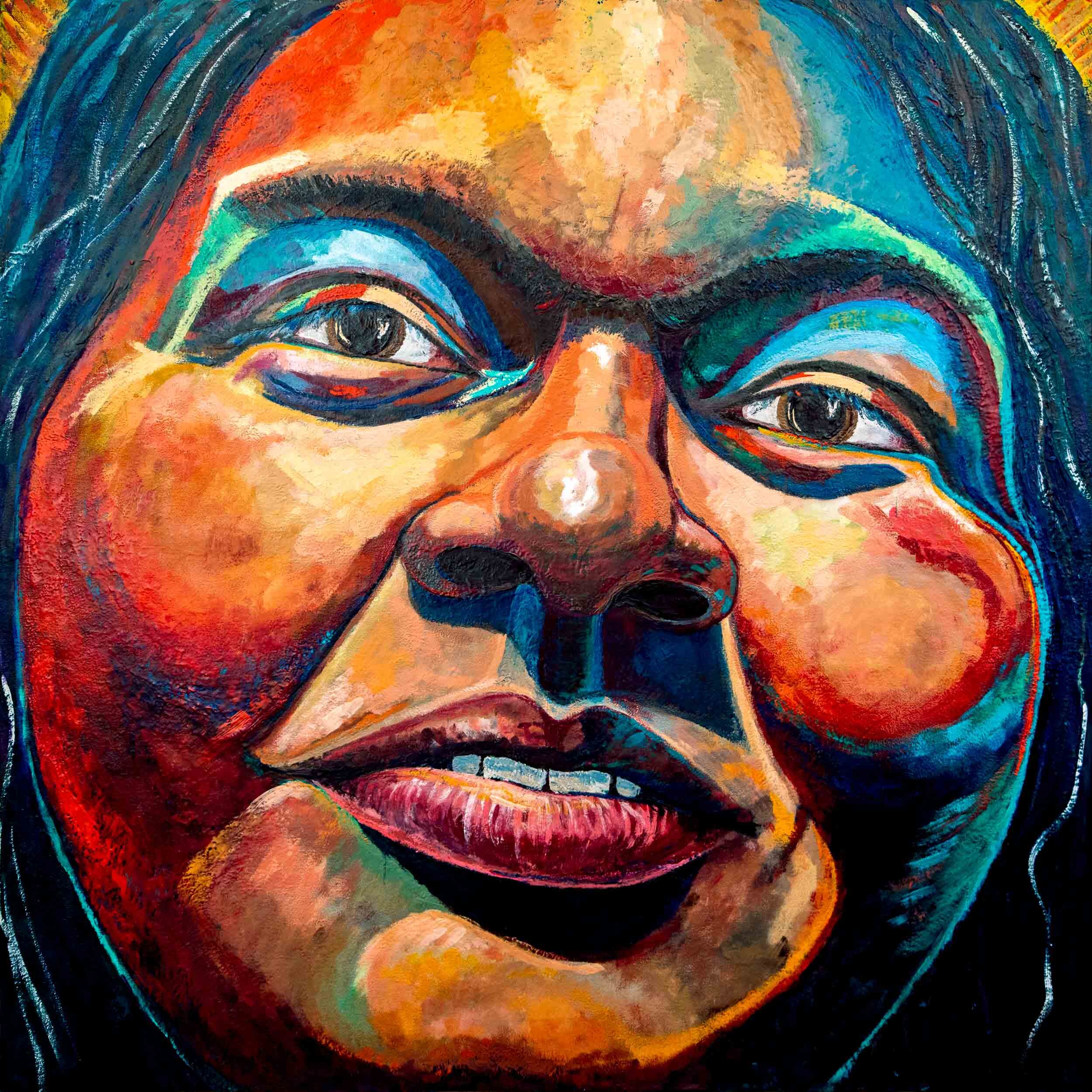Medusa’s Advocate
Impression of Joênia Wapixana
Medusa was not consulted; she was raped; her spiritual path: destroyed. The same is true for Indigenous people worldwide. Joênia Wapixana, the first indigenous lawyer of Brazil, defends Indigenous rights in environmentally protected areas endangered by mining and logging in the Amazon.
Joênia Wapixana, activist for Indigenous rights
“Taking care of the rainforest is important not only because of what it means for indigenous peoples, but also – given climate change – for the planet.”
Indigenous people around the world have not been consulted. Their lands have been stolen from them. They have been attacked, violated, vilified and murdered, like Medusa.
“Without land, we have no education, no health, no environment, and no economy. That’s why indigenous land demarcation is a human rights issue as well.
Either you fight for the human rights of your people or you lose everything.”
About Medusa
Originally Medusa was a beautiful woman, committed to a spiritual path, a priestess and advisor to her people, serving in the temple. Despite many proposals from ardent suitors, Medusa had chosen the spiritual path in order to be free of the constraints and obligations associated with taking a husband.
Priestess of Delphi, John Collier, 1891, Art Gallery of South Australia
Parallel this with the fact that Indigenous people in Brazil were following their own spiritual paths until the Europeans came along to impose their own beliefs and customs upon them.
Primeira Missa no Brasil, Victor Meirelles, 1861, reprodução: jovensconectados
Medusa’s beauty was such that many wondered if the Goddess Athena herself might be jealous. Poseidon, God of the Sea, took a fancy to Medusa and — determined to have his way with her — raped her in or on the steps of the temple.
Neptune, Antoine Coysevox, 1705, Louvre, Paris
Imagine the Europeans arriving in “the Americas”: contemplating the pristine beauty and awe-inspiring vistas. Arrogant, rapacious and greedy, they want and take everything they can: the land, the water, the gold, the men, women and children.
Itapoan, Jose Pancetti, 1957. Image via WikiArt
Medusa was given no choice in the matter. She was not consulted, she was not asked what she wanted for her life. Instead she was raped. Her spiritual path destroyed.
Similarly Indigenous people around the world have not been consulted. They were not asked. Their lands have been stolen from them. They have been attacked, violated and then dismissed, like Medusa.
Untitled, Lasar Segall, c.1940, private collection. image via WikiArt
Athena, furious at the desecration of her temple blamed Medusa, the victim, rather than Poseidon, the perpetrator.
Muller (A woman), Arturo Souto, 1954. Image via WikiArt
Characterized as ignorant savages, even cannibals, Indigenous people have been demonized, enslaved and destroyed — as was Medusa — Indigenous people have been mocked and derided, their spiritual ways dismissed as naive, unscientific, or even baseless, when instead these people are the guardians of the planet.
“Fighting for the climate today is fighting for Indigenous People to be heard.
It is fighting for the right to consultation.
It is fighting for existence on the planet!”
Across the globe, the protection of the natural resources of the planet is paramount for Indigenous peoples. Respect for the natural world is a core value. For Indigenous people, their core values have been violated just as Medusa’s values were violated.
Mulleres chorando (Women crying), Arturo Souto, 1954. Image via WikiArt
Athena then transformed Medusa’s beautiful hair into a tangle of writing serpents and banishes her to a remote land.
Indigenous people have been pushed onto reservations, progressively smaller and smaller tracts of lands — now constantly under threat of logging, mining and water pollution.
Animais No Pasto, Arthur Nísio. image via WikiArt
Perseus the conqueror then appears on the scene, aided by weapons of deceit, much like the poisoned blankets of the Europeans in North America. Creeping up on Medusa as she sleeps, Perseus lops off her head.
Persée et la gorgone, Laurent-Honoré Marqueste, 1890, Museum of Fine Arts of Lyon
The genocide of the indigenous people of Brazil began with the Portuguese colonization of the Americas in 1500. Over eighty indigenous tribes were destroyed between 1900 and 1957. The exploitation of the Amazon Rainforest for mining, logging and cattle ranching poses a grave threat to the indigenous population.
Eduardo Kobra: One piece from Ethnic, Rio, Brazil 2016, image via melkojournal.com.au
Under the current administration in Brazil, an area of Amazon rainforest the size of a soccer pitch is destroyed every minute. The current government is encouraging attacks against indigenous peoples and the theft and destruction of their territories; calling for forced “integration” of un-contacted tribes; attempting to open up territories to large-scale mining; and failing to protect them from COVID-19 by blocking health care plans to combat the virus in indigenous communities.
A família enferma, Lasar Segall, 1920. Image via WikiArt
Since Medusa was pregnant at the time of her assassination, from her neck spring her two as yet unborn children, Chrysaor and Pegasus. Furthermore, as Perseus flies back to deliver the head to Athena, the blood dripping from Medusa’s severed head morphs populates the land with snakes and serpents. Finally Athena places Medusa’s head on her shield so that its fearsome image might turn opponents to stone.
Medusa, Caravaggio. ca. 1597, Galleria degli Uffizi, Florence. Image via Wikicommons
How similar to Athena were the Portuguese, Spanish, French and English colonizers of the Americas? Athena: coveting Medusa’s radiant beauty, passion and even her subsequent rage that transcended death. The Portuguese: seeking the treasured red dye of the Brazilwood; the English, French and Spanish conquistadores: seeking gold, land and slaves to further their wealth.
Paisagem, Arthur Nísio. image via WikiArt
the demonization of Medusa & Indigenous people
For the Portuguese colonizers of Brazil, the focus was on evangelism and trade in Africa and Asia. This included human trafficking. Brazil was seen as a trade post rather than a place to send settlers. Adventurers and missionaries described the Indigenous inhabitants of Brazil as engaging in the practice of cannibalism, which was used as a justification for enslavement.
“Native Americans kill and eat a prisoner,” fold-out plate engraving, 18.4 cm, in Naaukeurige versameling der gedenk-waardigste zee en land-reysen na Oost en West-Indiën … zedert het jaar 1524 tot 1526 (Leiden: Pieter van der Aa, 1706), vol. 15, part 1, p. 56 (John Carter Brown Library)
The association of Indigenous people with cannibalism has had lasting influence, right up to twenty-first century art.
Tarsila do Amaral
Brazilian artist Tarsila do Amaral is considered one of the Latin America’s leading modernist artists, and one who best achieved the Brazilian aspirations for nationalistic expression in a modern style. Her painting Abaporu, given to her husband Oswald de Andrade as a birthday gift, inspired the Brazilian writer to write the Anthropophagic Manifesto which launched the Anthropophagic Movement which aimed to “swallow” European culture and transform it into a new Brazilian culture. The word “abaporu” is derived from two words from the language of the Tupi-Guarani people which means “the man that eats people” = abá (man) + poro (people) + ‘u (to eat).
“. . . [Abaporu] also became the banner for this transformative artistic movement, which diagnosed Brazil’s colonial trauma and imagined a national modern culture arising from the symbolic digestion—or artistic “cannibalism”—of outside influences.”
Abaporu, Tarsila do Amaral, 1928 (Photo credit: Museo de Arte Latinoamericano de Buenos Aires, Argentina
Joênia Wapixana
Joênia Wapixana is from the Wapixana tribe of northern Brazil. She is also the first indigenous lawyer of Brazil.
With altercations rising between loggers, miners and the native communities Wapixana sought to protect native rights in an environmental conservation area that had been constitutionally protected but was becoming increasingly at risk. Wapixana took the dispute to the Inter-American Commission on Human Rights and became the first indigenous lawyer to argue before the Supreme Court of Brazil. Currently Wapixana is President of the National Commission for the Defense of the Rights of Indigenous Peoples.
Joênia Wapixana has been honoured with the Reebok Human Rights Award (2004); the Ordem do Mérito Cultural from the Brazilian government (2010) and, in 2018, was awarded the United Nations Prize in the Field of Human Rights.
Joenia Wapixana
why do we continue to enable rape?
For a deeper sense of how depictions of women in the arts may influence our attitudes and actions towards women today, visit:
References
- https://www.ohchr.org/EN/NewsEvents/Pages/JoeniaWapixana.aspx
- https://womennart.com/2017/08/16/abaporu-by-tarsila-do-amaral/
- https://en.wikipedia.org/wiki/Tarsila_do_Amaral
- https://www.moma.org/artists/49158
- https://www.moma.org/calendar/exhibitions/3871
- New Larousse Encyclopedia of Mythology, Hamlyn Publishing Group Ltd., New York, 1959
- Ancient Mirrors of Womanhood, Merlin Stone, Beacon Press, Boston, 1984
- When God Was A Woman, Merlin Stone, Harvest Edition, 1976
- The Civilization of the Goddess, The World of Old Europe, Marija Gimbutas, HarperCollins Publishers, 1991
- The Language of the Goddess, Marija Gimbutas, HarperRow publishers, San Francisco, 1989
- https://www.khanacademy.org/humanities/art-americas/new-spain/colonial-brazil/a/an-introduction-to-colonial-brazil
- https://en.wikipedia.org/wiki/History_of_Brazil
- https://www.un.org/development/desa/indigenouspeoples/wp-content/uploads/sites/19/2018/11/UNDRIP_E_web.pdf
- http://blog.yalebooks.com/2017/12/01/brazils-first-art-cannibal-tarsila-do-amaral/
- https://en.wikipedia.org/wiki/Pythia
- https://medusatalksback.wordpress.com/medusa/
- https://en.wikipedia.org/wiki/Genocide_of_indigenous_peoples_in_Brazil
- https://www.survivalinternational.org/brazilgenocide


















